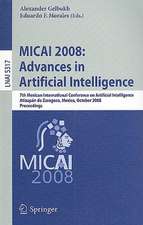Advances in Artificial Intelligence and Its Applications: 12th Mexican International Conference, MICAI 2013, Mexico City, Mexico, November 24-30, 2013, Proceedings, Part I: Lecture Notes in Computer Science, cartea 8265
Editat de Félix Castro, Alexander Gelbukh, Miguel González Mendozaen Limba Engleză Paperback – 22 noi 2013
Din seria Lecture Notes in Computer Science
- 20%
 Preț: 1061.55 lei
Preț: 1061.55 lei - 20%
 Preț: 340.32 lei
Preț: 340.32 lei - 20%
 Preț: 341.95 lei
Preț: 341.95 lei - 20%
 Preț: 453.32 lei
Preț: 453.32 lei - 20%
 Preț: 238.01 lei
Preț: 238.01 lei - 20%
 Preț: 340.32 lei
Preț: 340.32 lei - 20%
 Preț: 438.69 lei
Preț: 438.69 lei -
 Preț: 449.57 lei
Preț: 449.57 lei - 20%
 Preț: 343.62 lei
Preț: 343.62 lei - 20%
 Preț: 148.66 lei
Preț: 148.66 lei - 20%
 Preț: 310.26 lei
Preț: 310.26 lei - 20%
 Preț: 256.27 lei
Preț: 256.27 lei - 20%
 Preț: 645.28 lei
Preț: 645.28 lei - 17%
 Preț: 427.22 lei
Preț: 427.22 lei - 20%
 Preț: 655.02 lei
Preț: 655.02 lei - 20%
 Preț: 307.71 lei
Preț: 307.71 lei - 20%
 Preț: 1075.26 lei
Preț: 1075.26 lei - 20%
 Preț: 591.51 lei
Preț: 591.51 lei -
 Preț: 381.21 lei
Preț: 381.21 lei - 20%
 Preț: 337.00 lei
Preț: 337.00 lei - 15%
 Preț: 438.59 lei
Preț: 438.59 lei - 20%
 Preț: 607.39 lei
Preț: 607.39 lei - 20%
 Preț: 538.29 lei
Preț: 538.29 lei -
 Preț: 389.48 lei
Preț: 389.48 lei - 20%
 Preț: 326.98 lei
Preț: 326.98 lei - 20%
 Preț: 1414.79 lei
Preț: 1414.79 lei - 20%
 Preț: 1024.44 lei
Preț: 1024.44 lei - 20%
 Preț: 579.30 lei
Preț: 579.30 lei - 20%
 Preț: 575.48 lei
Preț: 575.48 lei - 20%
 Preț: 583.40 lei
Preț: 583.40 lei - 20%
 Preț: 763.23 lei
Preț: 763.23 lei - 15%
 Preț: 580.46 lei
Preț: 580.46 lei - 17%
 Preț: 360.19 lei
Preț: 360.19 lei - 20%
 Preț: 504.57 lei
Preț: 504.57 lei - 20%
 Preț: 172.69 lei
Preț: 172.69 lei - 20%
 Preț: 369.12 lei
Preț: 369.12 lei - 20%
 Preț: 353.50 lei
Preț: 353.50 lei - 20%
 Preț: 585.88 lei
Preț: 585.88 lei -
 Preț: 410.88 lei
Preț: 410.88 lei - 20%
 Preț: 596.46 lei
Preț: 596.46 lei - 20%
 Preț: 763.23 lei
Preț: 763.23 lei - 20%
 Preț: 825.93 lei
Preț: 825.93 lei - 20%
 Preț: 649.49 lei
Preț: 649.49 lei - 20%
 Preț: 350.21 lei
Preț: 350.21 lei - 20%
 Preț: 309.90 lei
Preț: 309.90 lei - 20%
 Preț: 122.89 lei
Preț: 122.89 lei
Preț: 347.91 lei
Preț vechi: 434.89 lei
-20% Nou
Puncte Express: 522
Preț estimativ în valută:
66.60€ • 69.49$ • 55.83£
66.60€ • 69.49$ • 55.83£
Carte tipărită la comandă
Livrare economică 13-27 martie
Preluare comenzi: 021 569.72.76
Specificații
ISBN-13: 9783642451133
ISBN-10: 3642451136
Pagini: 612
Ilustrații: XXVI, 585 p. 139 illus.
Dimensiuni: 155 x 235 x 32 mm
Greutate: 0.84 kg
Ediția:2013
Editura: Springer Berlin, Heidelberg
Colecția Springer
Seriile Lecture Notes in Computer Science, Lecture Notes in Artificial Intelligence
Locul publicării:Berlin, Heidelberg, Germany
ISBN-10: 3642451136
Pagini: 612
Ilustrații: XXVI, 585 p. 139 illus.
Dimensiuni: 155 x 235 x 32 mm
Greutate: 0.84 kg
Ediția:2013
Editura: Springer Berlin, Heidelberg
Colecția Springer
Seriile Lecture Notes in Computer Science, Lecture Notes in Artificial Intelligence
Locul publicării:Berlin, Heidelberg, Germany
Public țintă
ResearchCuprins
Some Properties of Logic N-GLukG.- The Inverse Method for Many-Valued Logics.- A Parametric Interpolation Framework for First-Order Theories.- Dalal’s Revision without Hamming Distance.- Default Assumptions and Selection Functions: A Generic Framework for Non-monotonic Logics.- Soft Constraints for Lexicographic Orders.- Expressive Reasoning on Tree Structures: Recursion, Inverse Programs, Presburger Constraints and Nominals.- Completion-Based Automated Theory Exploration.- Possibilistic Minimal Models for Possibilistic Normal Programs.- Knowledge-Based Systems and Multi-Agent Systems Estimating the Number of Test Cases for Active Rule Validation.- A Dynamic Multi-Expert Multi-Criteria Decision Making Model for Risk Analysis.- An Architecture for Cognitive Modeling to Support Real-Time Adaptation and Motivational Responses in Video Games.- Semantic Representation of CAD Models Based on the IGES Standard.- Complexity of Verification of Fuzzy Multi-Agent Systems.- Using Activity Theory and Causal Diagrams for Designing MultiAgent Systems That Assist Human Activities.- Challenges in Ontology Alignment and Solution to the Contradictory Evidence Problem.- Simple Window Selection Strategies for the Simplified Lesk Algorithm for Word Sense Disambiguation.- Disambiguating Wikipedia Articles on the Basis of plWordNet Lexico-semantic Relations.- Recognising Compositionality of Multi-Word Expressions in the Wordnet Oriented Perspective.- Automatic Processing of Linguistic Data as a Feedback for Linguistic Theory.- Interval Semi-supervised LDA: Classifying Needles in a Haystack.- A Reverse Dictionary Based on Semantic Analysis Using WordNet.- Applying Rogerian Psychologist in Human-Computer Interaction: A Case Study.- HuLaPos 2.0 – Decoding Morphology.- Hybrid Text Segmentation for Hungarian Clinical Records.- Detection and Expansion of Abbreviations in Hungarian Clinical Notes.- Composite Event Indicator Processing in Event Extraction for Non-configurationalLanguage.- Exploration of a Rich Feature Set for Automatic Term Extraction.- A Pseudo-Relevance Feedback Based Method to Find Comprehensive Web Documents.- Enhancing Sentence Ordering by Hierarchical Topic Modeling for Multi-document Summarization.- An Enhanced Arabic OCR Degraded Text Retrieval Model.- ELEXR: Automatic Evaluation of Machine Translation Using Lexical Relationships.- Modeling Persian Verb Morphology to Improve English-Persian Machine Translation.- An XML Based TBX Framework to Represent Multilingual SNOMED CT for Translation.- The Twin Hypotheses – Brain Code and the Fundamental Code Unit: Towards Understanding the Computational Primitive Elements of Cortical Computing.- Predicting Metabolic Syndrome with Neural Networks.- Homogeneous Population Solving the Minimal Perturbation Problem in Dynamic Scheduling of Surgeries.- CUP Classification Based on a Tree Structure with MiRNA Feature Selection.- Machine Learning Techniques Applied to the Cleavage Site Prediction Problem.- Human Heart Segmentation Based on Differential Evolution and Active Contours with Shape Prior.- Detection of Human Retina Images Suspect of Glaucoma through the Vascular Bundle Displacement in the Optic Disc.- Blood Vessel Segmentation in Retinal Images Using Lattice Neural Networks.- A Bayesian and Minimum Variance Technique for Arterial Lumen Segmentation in Ultrasound Imaging.- Detection of Masses in Mammogram Images Using Morphological Operators and Markov Random Fields.- A New Collection of Preprocessed Digital Mammograms.



























